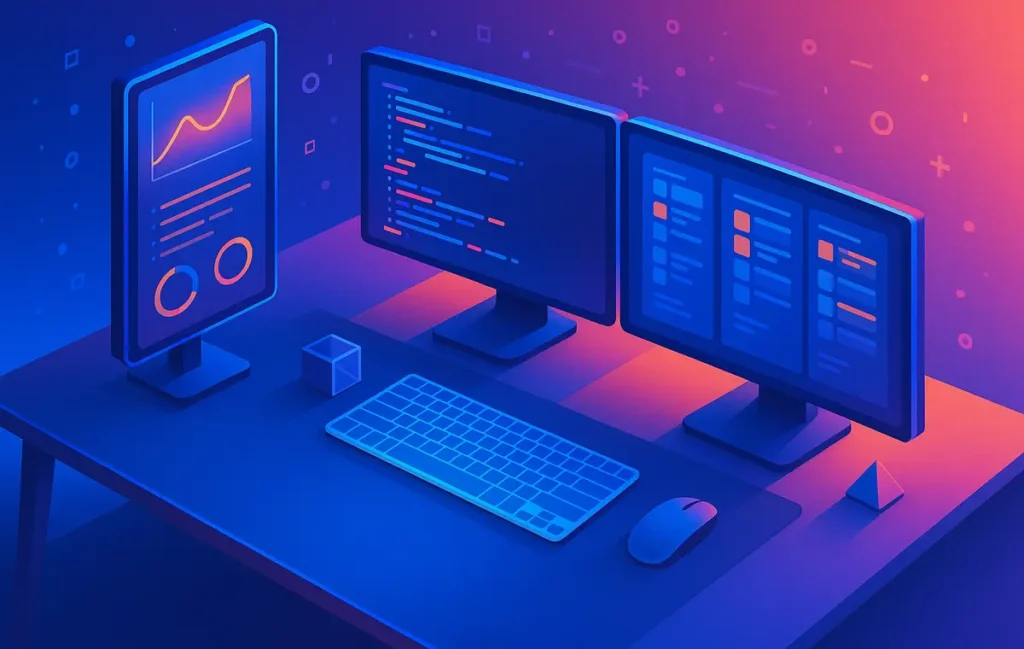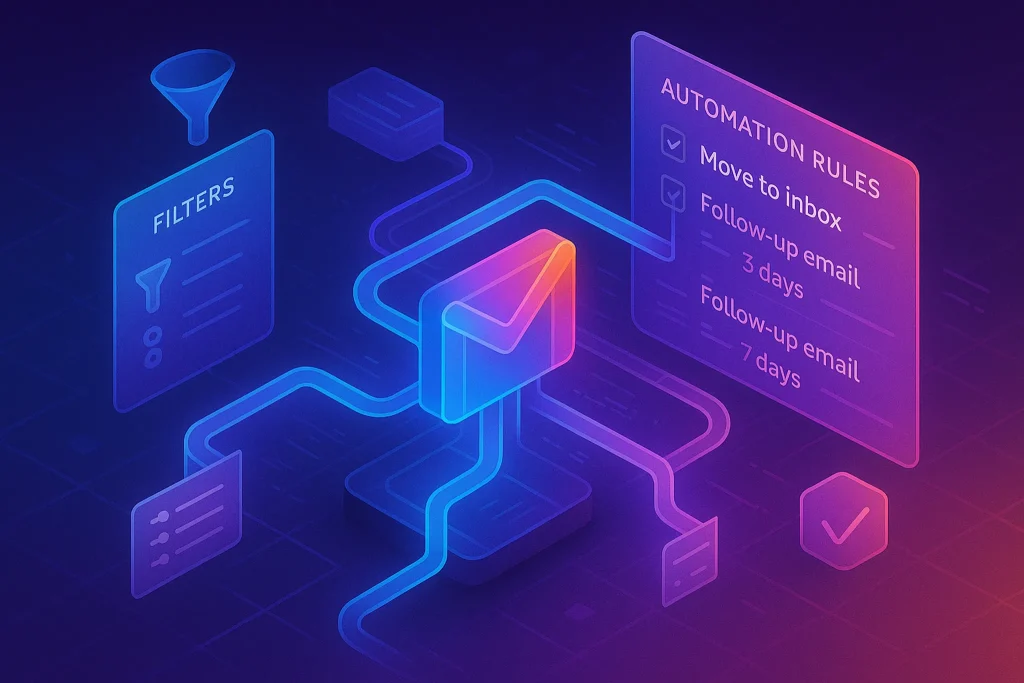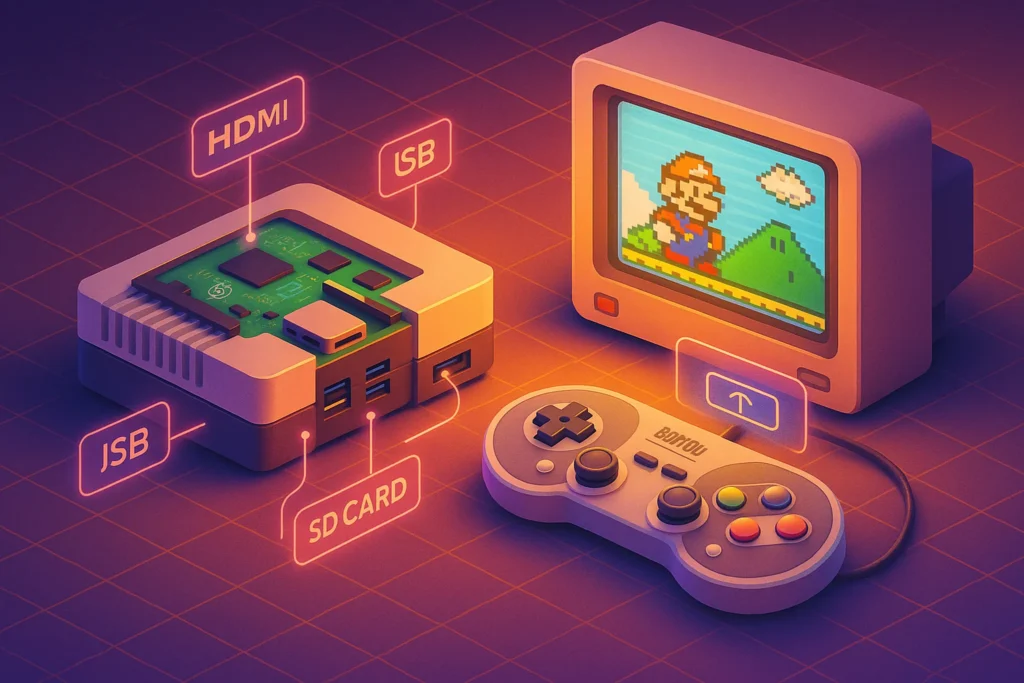🚀 Intro: More Screens, Same Productivity?
Adding a second or third monitor has become one of the most common “hacks” people try when they want to get more productive. But here’s the problem: most users stop at just plugging in a new display and expecting magic. The result? More pixels, but not necessarily more progress. Without the right arrangement, ergonomics, and workflow design, a multi-monitor setup can actually backfire—causing distraction, neck strain, or messy digital clutter.
Studies from workplace ergonomics research suggest that well-optimized multi-monitor setups can improve productivity by 30–50%. That’s a massive gain, but it only comes when you go beyond hardware and start designing a true system. At NerdChips, we believe the difference between “two screens” and a “multi-monitor workflow” is the difference between simply owning tools and mastering them. This guide will walk you step by step to build a setup that fuels focus, not chaos.
🖥️ Step 1: Choose the Right Monitors
The foundation of a great setup starts with choosing the right monitors. Resolution and size matter because they directly impact eye comfort and clarity. A 27-inch 1440p monitor is often the sweet spot for productivity—it offers enough real estate without overwhelming your desk or GPU. Creatives working with photography, video editing, or design should consider 4K monitors, as pixel density makes a significant difference for color accuracy and detail. If you’re deciding between models, see our guide on How to Choose a High-Resolution Monitor for Creatives for deeper insight.
Another key decision is whether to match your monitors or mix them. Matching monitors (same size, resolution, and color calibration) provide a seamless viewing experience, while mixing can allow for specialized use—for example, pairing a widescreen primary monitor with a vertical secondary for coding or writing. Speaking of orientation, a vertical monitor can dramatically improve document reading, coding, or referencing long research papers. This configuration is often overlooked, but when used correctly, it transforms how efficiently you process information.
💡 Nerd Tip: Don’t think of monitors as “duplicates.” Assign each one a specific role—main, reference, or communications. Without roles, multitasking becomes chaos.
🪑 Step 2: Optimize Ergonomics
Ergonomics is where most people fall short. A poorly arranged setup may boost short-term productivity but will hurt you in the long run with neck strain, back pain, and eye fatigue. The center of your primary monitor should be at eye level, and the distance should be roughly an arm’s length away. Too close, and you’ll be constantly darting your eyes; too far, and you’ll lean forward, stressing your posture.
Using monitor arms is one of the most powerful upgrades you can make. They allow precise height and depth adjustments, reduce desk clutter, and create the feeling of a “floating workspace.” Combined with a desk deep enough to provide a natural viewing angle, monitor arms make it easier to maintain healthy posture throughout long work sessions.
Lighting is another overlooked factor. If your monitors sit opposite a window, glare can destroy your visual comfort. Anti-glare screen protectors or repositioning the setup can solve this. Pairing monitors with ambient desk lighting also reduces eye strain. Ergonomics isn’t just about health—it directly impacts how long you can stay in flow.
For users building setups in compact environments, portable solutions like USB-C monitors can be a lifesaver. They provide extra space without forcing a permanent desk rearrangement, making them ideal for hybrid workers or students.
🧩 Step 3: Configure Smart Layouts
The way you arrange content across multiple monitors defines whether the setup feels empowering or overwhelming. Always assign your main display as the “focus zone.” This is where your core tasks live—documents, coding windows, or editing timelines. The secondary monitor should serve as a reference screen for tools you need to glance at but don’t want cluttering your main focus: research articles, charts, or side documents.
A third monitor, if you use one, is best reserved for communication tools like Slack, email, or video calls. This prevents interruptions from bleeding into your main workspace. For coders and writers, a vertical screen is especially powerful—it allows you to view long chunks of code or manuscripts without constant scrolling.
This division of labor creates psychological zones. When you look at one monitor, your brain knows you’re in “focus mode.” When you glance at another, it knows you’re checking resources. It’s a subtle but powerful way to train productivity. For gaming, this approach is often about immersion, but for work, it’s about intentionality—something we broke down further in our article on How to Set Up a Dual-Monitor Gaming Station.
⌨️ Step 4: Workflow Hacks
Hardware is only half the battle. The real gains come from using software tricks and system shortcuts that make navigating multiple screens effortless. Windows users can master combinations like Win+Shift+Arrow to move windows between monitors instantly. Mac users can lean on Mission Control and tools like Spaces to create virtual desktops mapped across their displays.
Virtual desktops are especially powerful for keeping focus. Imagine having one set of screens for deep work, another for research, and another for communication. Switching between them reduces the sense of clutter while giving you a mental reset.
Cross-app workflows can also multiply efficiency. A popular setup is email on the left, documents in the center, and chat on the right. This mirrors real-world communication flow: incoming, processing, and responding. Designers and editors often put tool palettes on one monitor and a distraction-free canvas on another. Writers sometimes dedicate an entire screen to reference documents while keeping their main writing window clean.
💡 Nerd Tip: Think of your digital space like a physical desk. Each zone should have a clear function. Mixing everything together is like piling your desk with papers—you won’t find anything fast.
⚙️ Step 5: Automation & Tools
Once you’ve built the structure, the next step is optimizing it with software. Tools like DisplayFusion (Windows) let you save and load monitor profiles, meaning you can switch from “work mode” to “entertainment mode” with a single click. Mac users have excellent lightweight tools like Magnet and Rectangle, which allow you to snap windows into predefined positions, ensuring your layouts are consistent.
Hotkey automation is another underrated hack. Imagine pressing a single key to open your browser on the left monitor, your document in the middle, and your task manager on the right. Over time, these micro-savings add up to hours of regained focus.
For cloud workers, syncing layouts across devices is increasingly important. Tools that store window configurations in the cloud mean you can sit down at different desks—home, office, or coworking—and instantly replicate your familiar workflow. This is particularly valuable for hybrid professionals who move between multiple environments.
If you want more detail on setting up connections in the first place, check our guide on How to Connect Two Monitors to a Laptop. Once you master connections, automation takes your setup from functional to flawless.
⚠️ Step 6: Common Mistakes & Fixes
Multi-monitor productivity fails most often because of preventable mistakes. One of the most common is mismatched resolutions. Running a 4K screen next to a 1080p display can create visual fatigue as your eyes constantly adjust. Ideally, keep resolutions consistent or scale them properly in your OS settings.
Another pitfall is over-cluttering. Just because you have more space doesn’t mean you should fill it with endless apps. Too many open windows leads to decision fatigue and makes it harder to focus. A minimalist approach—dedicating screens to specific roles—is far more effective.
Ergonomics also plays into mistakes. Placing monitors too high or too wide can cause shoulder tension and neck pain. Always prioritize comfort. Finally, don’t overlook cable management. A messy setup creates subconscious stress, while clean lines and hidden wires support a sense of order. A productive setup isn’t only about pixels—it’s about how the entire environment feels.
💡 Nerd Tip: Treat your setup like a team. If each monitor has no clear role, the workflow will collapse into confusion. Define roles, keep it clean, and your productivity will soar.
🖥️ Two Screens, Twice the Focus
Adding monitors doesn’t just expand space—it multiplies productivity when set up right. Build smarter layouts and let each screen play its role.
🔋 Energy & Focus Management
Productivity with multiple monitors isn’t only about physical space—it’s also about managing mental energy. When every screen is filled with unrelated tasks, your brain is forced into constant context switching, which is one of the biggest drains on focus. Studies on multitasking show that shifting between different tasks can reduce efficiency by as much as 20–30% because the brain needs recovery time after every switch. With a well-structured multi-monitor setup, you can minimize this friction by assigning “zones of focus.” One monitor is dedicated purely to your main task, another is reserved for reference materials, and a third handles communication. By visually separating workflows, your brain learns to stay in the right mental lane. This not only boosts focus but also reduces the exhaustion that comes from juggling too many contexts at once.
💡 Nerd Tip: Treat your monitors like rooms in a house. You wouldn’t cook, sleep, and work all in one room—so don’t mix all tasks on one screen.
🎨 Designing the Aesthetic Environment
An overlooked but powerful part of multi-monitor productivity is the environment’s visual design. Cable clutter, mismatched wallpapers, and poorly aligned screens create subconscious stress. On the other hand, a clean aesthetic signals control and calm. Simple steps like investing in cable sleeves or mounting a power strip under the desk can completely change the feel of your setup. Matching wallpapers across screens or using panoramic designs that stretch across monitors give your workspace a cohesive look. Even small touches, like keeping bezels aligned at equal height or using monitors with similar color profiles, reduce visual distraction. A well-designed environment doesn’t just look better—it keeps your mind in a productive state by eliminating micro-irritations that chip away at focus throughout the day.
⏱️ Timeboxing with Multi-Monitor Workflows
Multi-monitor setups shine when combined with structured time management methods. Timeboxing or Pomodoro cycles become more effective when each monitor plays a role in the system. For example, during a 50-minute deep work session, the central monitor holds your main project, while a secondary screen displays a time tracker or Pomodoro timer, and the third screen is intentionally silenced for communication until your break. When the timer rings, you know exactly when to shift zones without mentally negotiating whether it’s time to check Slack or email. This integration of spatial separation and temporal discipline creates a powerful rhythm that keeps you focused and reduces procrastination. By letting your monitors guide not just what you work on, but when, you align your environment with your productivity goals.
🌍 Remote Work & Hybrid Benefits
For remote and hybrid workers, multi-monitor setups are not a luxury—they are a survival tool. Juggling video calls, messaging platforms, and documents on a single laptop screen is overwhelming and leads to constant tab-switching fatigue. With two or more monitors, you can dedicate one screen to Zoom or Teams, another to collaborative docs, and a third to communication tools like Slack or email. This separation mirrors the multitasking reality of remote work without burying you under digital clutter. It also enhances presence in meetings: instead of hiding behind stacked windows, you can keep faces visible while still referencing notes or slides. Companies adopting remote policies increasingly encourage employees to invest in multi-monitor setups because the productivity benefits translate directly into smoother communication and faster project turnaround. In hybrid environments, portable add-ons like USB-C travel monitors extend these benefits beyond the home desk, proving that extra screens make flexibility sustainable.
🔮 The Future of Multi-Monitor Productivity
Looking ahead, multi-monitor productivity is about to be redefined by technology. Ultra-wide OLED monitors are already replacing dual-screen setups by providing a seamless canvas without bezels. For professionals in video editing or trading, these 49-inch displays deliver the same real estate as two or three monitors but in a single continuous field of view. Augmented Reality (AR) takes this even further: imagine wearing lightweight glasses that project unlimited virtual monitors around you, creating a workspace without physical limitations. Companies like Meta and Apple are experimenting in this area, hinting at a future where physical monitors may become optional. Docking solutions are also evolving—laptops and even smartphones can now power multi-monitor workstations, making powerful setups more accessible to mobile workers. The future isn’t about simply adding more screens—it’s about blending physical and virtual display spaces into a fluid, context-aware environment that adapts to how we work.
📬 Want More Smart Workspace Insights?
Join our free newsletter and get weekly strategies on productivity setups, AI tools, and no-code workflows. Straight from NerdChips to your inbox.
🔐 100% privacy. Only practical, value-packed workspace tips from NerdChips.
🧠 Nerd Verdict
A multi-monitor setup can either be the ultimate productivity engine or an expensive distraction hub. The difference lies in intention. With the right monitors, ergonomic positioning, smart layouts, and automation tools, you transform scattered multitasking into structured focus. When you design each screen with purpose, your workflow expands in ways a single display can’t match.
❓ FAQ: Nerds Ask, We Answer
💬 Would You Bite?
If you had the option to add a third monitor, would you go for a vertical display to supercharge coding and writing, or keep all three horizontal for multitasking power?
Crafted by NerdChips for creators and professionals who want every screen to count toward better ideas and faster output.



